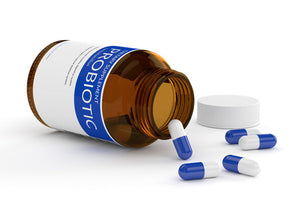PRObiotics vs. PREbiotics – What You Need to Know
February 05, 2018

Many people do not realize that their bodies play host to tens of trillions of bacteria and that the microorganisms living inside them play a big role in human health. Some of the bacteria, viruses, yeast and other microorganisms can cause ill health. Probiotics are living microorganisms that, in adequate amounts, can provide a health benefit to the host.
All living organisms, including the microbiota living in the gut, need food to survive. Probiotics living in the gut consume carbohydrates. They get these carbohydrates, known as prebiotics, from the food the host eats.
Most, but not all, prebiotics are a type of dietary fiber that is indigestible by human enzymes, our gut relies upon the bacteria to digest them. Since we cannot digest them, they serve as ‘food’ for the various microbes living in our gut.
Many foods contain prebiotics, including:
- Chicory root
- Dandelion greens
- Jerusalem artichoke
- Garlic
- Onions
- Leeks
- Asparagus
- Bananas
- Oats
- Soybeans
While these foods contain prebiotics, they are not terribly rich in them. This means a person would have to eat large quantities of these prebiotic-rich foods to sustain a healthy colony of probiotics. This is especially true for individuals who take probiotic supplements, as they have larger colonies of beneficial bacteria to feed. Taking prebiotic supplements in addition to eating prebiotic-rich foods would make sense, then, as a way to feed large colonies of probiotics gained from food and supplements.
However, feeding beneficial bacteria is only half the story.
For first-time customers
Save Now
Get 50% OFF our Healthy Trinity 30-count probiotics (plus $9.95 P&H).
Apply discount code BESTTIME at checkout.
Shop Now
PREbiotics Feed Unhealthy Bacteria Too
Unhealthy bacteria, viruses, yeast, and other pathogens eat the same carbohydrates as beneficial bacteria, so prebiotics also promote the growth of these unhealthy microorganisms. Taking a prebiotic may encourage the growth of yeast, for example.
Prebiotics may support the growth of Klebsiella, E. coli, Salmonella and other harmful bacteria. Feeding these pathogens can have devastating consequences. Pneumonia from Klebsiella infections is major cause of antibiotic-resistant infections worldwide, for example, while E. coli infections cause an estimated 96,000 illnesses, 3,200 hospitalizations and 31 deaths in the United States each year.
Due to diet and other factors, many Americans have an imbalance of gut organisms skewed in favor of potentially harmful organisms. Using a prebiotic may help pathogens survive and thrive to make the imbalance even worse.
PREbiotics Can Cause Side Effects
Prebiotics can cause unhealthy side effects. One prebiotic, fructooligosaccharide (FOS), may actually damage the intestinal barrier that prevents harmful pathogens in food from entering the body. FOS may impair the intestinal barrier in ways that allows unhealthy components of food into the body. Side effects associated with FOS include diarrhea, bloating, cramping, abdominal rumbling, and excessive flatulence.
Many people use probiotic supplements to ease digestive upset, so they may not appreciate the side effects associated with FOS.
Research shows another prebiotic, inulin, can actually cause unexpected shifts in the total bacterial community inside the consumer’s digestive tract by feeding uncommon bacteria living there. Other research suggests an association between inulin and the formation of intestinal tumors in mice.
Prebiotics are also an area of concern outside the body. Some skin care practitioners advocate the use of prebiotics on the skin as a way of feeding good bacteria on the outside, however this also gives a lifeline to the bad bacteria and organisms that live on our skin. For more information on how gut and skin health are related, check out our recent blog on the topic.
Natren’s Solution : The Intrinsic Supernatant – A Natural Food Source for PRObiotics
As with all other living organisms, the live bacteria in probiotic supplements must have food to survive. During the manufacturing process, probiotic makers provide the bacteria with a nutritionally balanced food base that allows the bacteria to grow, multiply, and thrive inside the gut.
Probiotic makers formulate each food base to optimize the health-promoting properties of the bacterial strain it feeds. In other words, one strain of probiotics may receive a different food than another strain to bring out the strain’s special nutritional benefits.
As bacteria grow, they transform the food into an active and essential byproduct, known as the supernatant. Growing bacteria also produce and release hydrogen peroxide, acidophilin, and vitamins into the supernatant. The supernatant becomes the natural food source for the probiotics; it also enhances the health properties of the beneficial bacteria.
Many probiotic manufacturers do not provide adequate food for their live bacteria and opt instead to add more bacterial cells to the final product in hopes that enough will live long enough to provide benefit to the consumer. They do this to save money, since including the intrinsic supernatant in the final product is an added expense.
Natren includes the intrinsic supernatant in their final product so that their bacteria have something nutritious to eat. Because the probiotics carry their own food source, prebiotics are simply unnecessary. Furthermore, providing bacteria-specific supernatants means there is no need to add FOS, inulin or other fillers to these probiotics.
Researchers in a 2014 study found that Natren’s Lactobacillus acidophilus NAS super strain secretes bacteriocins into its supernatant. Bacteriocins are natural antimicrobials, so they add to the health benefits provided by Natren’s probiotics. The supernatants in Natren also protect the probiotics from the harsh environment stomach acid creates, and this protection helps Natren probiotics survive and thrive in the gut.
Natren provides an optimal environment for probiotics to help beneficial bacteria survive and optimize the health benefits associated with probiotics.
The post PRObiotics vs. PREbiotics – What You Need to Know appeared first on Natren Probiotics Blog.





Leave a comment